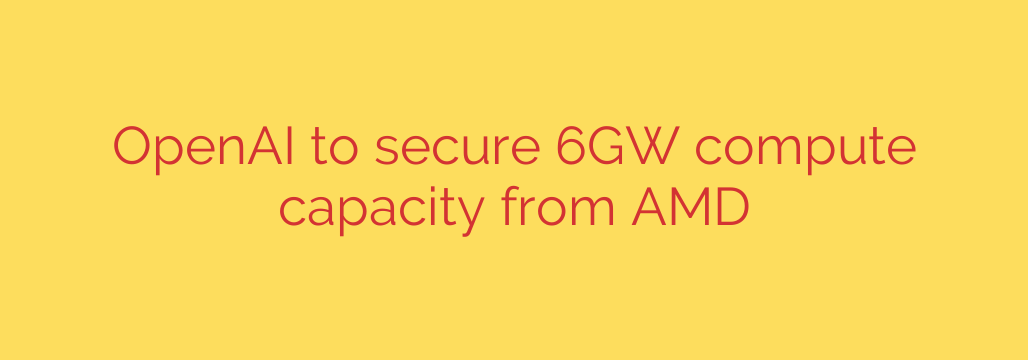
The 6-Gigawatt Leap: A Look Inside the Massive AI Infrastructure Powering Our Future
The world of artificial intelligence is fueled by data and processing power, and the demand for that power is growing at an exponential rate. In a move that signals the sheer scale of what’s to come, major AI developers are now securing energy and hardware on a level previously unimaginable. A monumental plan is underway to secure a staggering 6 gigawatts of computing power, a figure that fundamentally changes our understanding of the resources required for next-generation AI.
This massive undertaking highlights a critical shift in the technology landscape, underscoring the immense energy and hardware foundation needed to build and train future AI models like GPT-5 and beyond.
Putting 6 Gigawatts into Perspective
To understand the magnitude of this number, consider this: 6 gigawatts (GW) is the equivalent of the power generated by approximately six large nuclear power plants. It’s enough energy to power millions of homes continuously. Dedicating this level of power to a single technological pursuit—AI computation—is unprecedented.
This isn’t just about keeping servers running; it’s about building an infrastructure capable of handling AI models that are exponentially more complex than what we have today. Training advanced AI requires vast, parallel processing capabilities, and the energy required to power and cool these massive server farms is one of the biggest challenges facing the industry.
A Strategic Shift in the AI Hardware Landscape
For years, the AI hardware market has been dominated by a single key player. However, this move to secure such vast capacity signals a major strategic diversification. Leading AI companies are now looking to build a more resilient and competitive supply chain, and AMD is emerging as a powerful contender.
With its advanced MI300X Instinct accelerators, AMD offers a compelling alternative for high-performance AI workloads. By working closely with chipmakers like AMD, AI developers can:
- Mitigate Supply Chain Risks: Relying on a single supplier for critical components creates a significant bottleneck. Diversifying ensures a more stable and predictable hardware supply.
- Foster Competition and Innovation: Increased competition in the GPU market can lead to better pricing, more rapid innovation, and a wider range of technological solutions.
- Secure Unprecedented Scale: This collaboration is a clear vote of confidence in AMD’s ability to deliver the performance and scale required for cutting-edge AI research and deployment.
This partnership is not just a massive purchase order; it’s a strategic alliance that could reshape the balance of power in the semiconductor industry for the next decade.
Powering the Next Generation of AI Models
The ultimate goal of this immense infrastructure investment is to pave the way for artificial intelligence systems that are far more capable than current models. The computational power being assembled is earmarked for training and running foundational models that will likely define the next era of technology.
We can expect these future systems to have:
- Enhanced Reasoning and Logic: More sophisticated problem-solving abilities across a wide range of domains.
- True Multimodality: Seamlessly understanding and generating content across text, images, audio, and video.
- Greater Reliability and Accuracy: Reducing the instances of errors or “hallucinations” that can affect current large language models (LLMs).
This 6-gigawatt infrastructure is the launchpad for developing AI that is more integrated, intelligent, and transformative than anything we’ve seen before.
The Unspoken Challenge: Energy and Sustainability
While the technological ambition is awe-inspiring, it also brings a critical challenge into sharp focus: the environmental impact of AI. Consuming gigawatts of power carries an enormous responsibility. The conversation around AI’s future must include a serious commitment to sustainable energy and efficient infrastructure.
As data centers scale to these new dimensions, the industry must prioritize:
- Sourcing Renewable Energy: Powering AI farms with solar, wind, and other green energy sources is essential for responsible growth.
- Developing Efficient Cooling: Data centers generate immense heat, and finding energy-efficient ways to cool them is a key engineering challenge.
- Optimizing AI Models: Researchers are continuously working on making AI models more efficient, requiring less computational power to achieve the same or better results.
The quest for more powerful AI cannot be separated from the quest for a sustainable planet. Building this future responsibly is not just an option—it is a necessity. This monumental investment in computing power is a glimpse into a future where AI’s capabilities are limited only by our imagination and our ability to power it.
Source: https://datacentrereview.com/2025/10/openai-signs-6gw-compute-agreement-with-amd/








